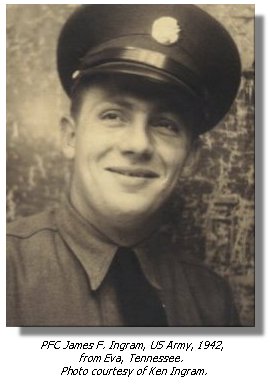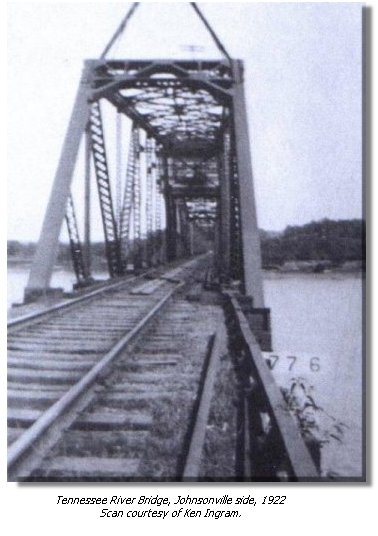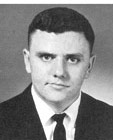|
|
|
My father, James
F. Ingram, was born in Eva, Tennessee, and then spent his childhood
and teenage years alternating between Memphis and Eva. One summer
afternoon in 1934 while "up at Eva", the year before
he graduated from Memphis Technical High
School, my dad and a bunch of
his cousins and friends, including first cousin and best friend Bill
Latham, decided to take a walk over the Tennessee River bridge to
Johnsonville. In those days, that was how you got over there; there
was no highway bridge back then. This was the high point of their
youth; very soon would come the struggle to make a living out of the
Great Depression, and all went on to honorable service during World
War II. But this day, they were all together, and headed for
Johnsonville because, quote, "That's where the girls were", unquote.
Eva was located on
the west bank of the Tennessee, and the NC&StL main line sort of
paralleled the river past the town, over a long elevated rail bed
and concrete trestle. This elevated levee, over which ran the NC&StL
main line, was made necessary by annual flooding of the bottom land
on this side of the river. The levee rail bed "islands" and trestle
are still visible above the waters of Kentucky Lake to this day;
plenty of catfish, crappie, bream, carp and bass caught in the
immediate vicinity of the remains of the concrete trestle.
|
 |
|
The railroad then
made a sweeping curve to the right and crossed the big river via a
long, steel-superstructure swing bridge, and proceeded more or less
straight through Johnsonville before angling off toward Nashville at
Denver. Old Johnsonville was a considerably larger town than Eva,
and offered more in the way of "entertainment".
|
 |
After
hiking the cross ties and crossing the high trestle came the most
adventurous part of the afternoon - crossing the bridge. If
fortunate enough to miss a train, another adventure might ensue
should the bridge tender decide to open the swing span in order to
facilitate a passing barge tow or steam boat. Last, but certainly
not least, there were no walkways or guardrails. It was cross ties
on top of girders all the way across. With luck, they could make it
to Johnsonville, spend the evening with their female acquaintances,
maybe even catch a film - Johnsonville boasted a movie house,
something tiny Eva would never have.
Well, lady luck wasn't with them
that summer afternoon. At about mid-point of their so-called "walk"
across the bridge, an afternoon timed freight steam locomotive
whistle announced imminent danger. What to do? To a man, they
immediately decided to high-tail it back to Eva! So, hopping ties,
off they went. They hadn't got far when the locomotive entered the
bridge structure, causing the old bridge to rumble. The engineer,
seeing these local trespassers to NC&StL property just ahead of his
train, began "laying it down" on the whistle. Four or five fellows
kept hopping ties in an effort to clear the bridge; my dad and Bill
Latham, pulling up the rear, decided to leap outside the rails to
the side of the bridge, hanging on for dear life between
superstructure girders, realizing that outrunning the train was
futile. As Bill relates the story, |
"That old engineer shook a mean fist at us as the locomotive went
past. I'll never forget him". Those other fellows just made it,
leaping out of harm's way at the last possible moment. This
anecdotal little yarn, first told to me years ago, kindled an avid
curiosity and interest in an old, long gone railroad for yours
truly. Only too soon, there won't be anyone left to remember the
tales of either Eva before the TVA or the old NC.
--Ken Ingram
|
|
|
Thanks to Aaron Hatch, Tech 1966 for sending
us this article.
|

Aaron Hatch, Tech 1966 |
|